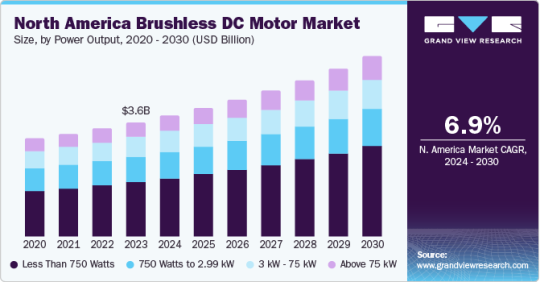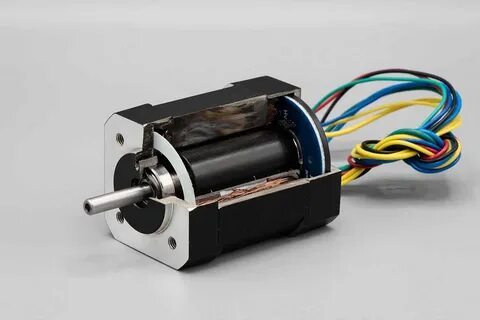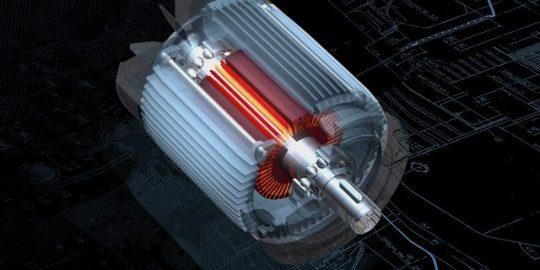#brushless dc motor market
Explore tagged Tumblr posts
Text
The global Brushless DC Motor Market is expected to reach USD 17.6 billion by 2028 from USD 12.1 billion in 2023 at a CAGR of 7.9% during the 2023–2028 period according to a new report by MarketsandMarkets™. The increasing adoption of Brushless DC motors is driven by their precise speed control, low maintenance requirements, and high efficiency. Brushless DC motors offer enhanced reliability, reduced electromagnetic interference, and compact designs, making them essential in applications where these attributes are critical, such as in medical devices, aerospace, and automation equipment.
#brushless dc motor market#brushless DC motors#brushless motor#brushless dc motor#electric motors#electric mobility#electric motor#electric motor sales#electric motor sales market#energy#energia#power generation#utilities#power#utility#hvac solutions#hvac contractors#hvac contractor#hvac services#HVAC#hvacparts#hvac installation#hvac maintenance#air conditioning#hvac system#automation#agriculture#consumer electronics
0 notes
Text
Brushless DC Motor Market Likely To Reach Beyond $30,862.4 Million By 2030
The global brushless DC motor market is expected to reach USD 30,862.4 million by 2030, registering a compounded annual growth rate (CAGR) of 6.5% from 2024 to 2030, according to a study conducted by Grand View Research, Inc. These motors are thermally resistant, require low maintenance, and operate at low temperatures, eliminating any threat of sparks. Low-cost maintenance, high efficiency at lower costs, and the rising adoption of Electric Vehicles (EVs) are some of the key factors driving the product demand over the forecast period.
The emergence of sensor-less controls for brushless DC (BLDC) type is likely to boost the durability and reliability of the product, thereby reducing the number of mechanical misalignments, electrical connections, as well as the weight and size of the end product. These factors are further estimated to drive market growth over the forecast period. Furthermore, the growing production of vehicles, globally, to cope up with the rising demand is anticipated to have a positive impact on the market growth.
The product is extensively used in motorized vehicle applications, such as in sunroof systems, motorized seats, and adjustable mirrors. In addition, these powertrains are extensively being preferred for performance applications in vehicles, such as chassis fittings, power-train systems, and safety fittings, owing to simple structure, fewer maintenance requirements, and extended operational life. Thus, increasing product adoption by the automobile industry for multiple applications is anticipated to drive the market over the forecast period.
Rising product usage in EVs in mechatronic systems, primarily in batteries for accumulators and power electronic converters, owing to advantages, such as high operating speed, compact size, and quick response time, will also augment the market growth. The production of EVs is on the rise, globally, supported by government initiatives to encourage the usage of non-conventional fuels and effectively reduce the adverse impacts of carbon emissions. Thus, the increasing EV production is anticipated to directly influence the product demand over the forecast period.


Brushless DC Motor Market Report Highlights
The brushless DC motor is expected to grow significantly on account of the benefits of these motors such as durability, low power consumptions, and less maintenance.
Less than 750 watt brushless DC motor segment is expected to witness rapid growth from 2024 to 2030, which can be primarily ascribed to their extensive applications in numerous motor vehicles and household devices applications.
Motor vehicles extensively use these for variety of applications. Increased production of automobiles and e-vehicles across the globe is anticipated to positively impact the growth of motor vehicle segment over the forecast period.
The industrial machinery segment held 24% of the global market in 2023. Numerous industrial machines deploy brushless DC motors owing to advantages offered such as high efficiency, low power consumption and low maintenance costs among others.
Asia Pacific is expected to emerge as the fastest-growing regional market, whilst registering a CAGR exceeding 7.8% from 2024 to 2030. Increasing industrialization in developing nations such as China, India and South Korea has fueled the adoption of brushless DC motor in the region.
The key players capturing major market share include ABB Ltd, Ametek Inc., Johnson Electric and Nidec Motor Corporation, among others. Numerous companies are focusing on developing low-maintenance and eco-friendly products in order to gain a competitive edge.
Brushless DC Motor Market Segmentation
Grand View Research has segmented the global Brushless DC Motor Market report based on rotor type, power, speed, end-use, and region
Brushless DC Motor Rotor Type Outlook (Revenue, USD Million, 2017 - 2030)
Inner Rotor
Outer Rotor
Brushless DC Motor Power Output Outlook (Revenue, USD Million, 2017 - 2030)
Less than 750 Watts
750 Watts to 2.99 kW
3 kW - 75 kW
Above 75 kW
Brushless DC Motor Speed Outlook (Revenue, USD Million, 2017 - 2030)
Less than 500 RPM
501-2,000 RPM
2,001-10,000 RPM
More than 10,000 RPM
Brushless DC Motor End-use Outlook (Revenue, USD Million, 2017 - 2030)
Industrial Machinery
Motor Vehicles
Safety
Comfort
Performance
HVAC Equipment
Aerospace & Transportation
Household Appliances
Others
Brushless DC Motor Regional Outlook (Revenue, USD Million, 2017 - 2030)
North America
U.S.
Canada
Europe
U.K.
Germany
France
Asia Pacific
China
Japan
India
South Korea
Australia
Latin America
Brazil
Mexico
Middle East and Africa (MEA)
Kingdom of Saudi Arabia (KSA)
UAE
South Africa
List of Key Players of Brushless DC Motor Market
ABB
Ametek Inc.
Johnson Electric Holdings Limited.
NIDEC CORPORATION
Allied Motion Technologies, Inc.
WorldWide Electric
Schneider Electric
Regal Rexnord Corporation
Siemens
TECO Corporation
MinebeaMitsumi Inc.
ORIENTAL MOTOR USA CORP
0 notes
Text
#Brushless DC Motor Market#Brushless DC Motor Market Trends#Brushless DC Motor Market Growth#Brushless DC Motor Market Industry#Brushless DC Motor Market Research#Brushless DC Motor Market Report
0 notes
Text
The Global Brushless DC Motor market is anticipated to rise at a considerable rate during the forecast period, between 2023 To 2030. In 2022, the market is growing at a steady rate and with the rising adoption of strategies by key players, the market is expected to rise over the projected horizon.
0 notes
Text
Brushless DC Motors Market Analysis and Future Trends 2024 - 2032
The brushless DC (BLDC) motors market is rapidly emerging as a vital element in various industries, driven by the demand for efficient and reliable motor solutions. With their advantages in energy efficiency, performance, and durability, BLDC motors are gaining traction across sectors such as automotive, aerospace, consumer electronics, and industrial automation. This article explores the current state of the brushless DC motors market, key drivers, challenges, and future trends.

Introduction to Brushless DC Motors
Brushless DC motors are electric motors that use electronic controllers to manage the power delivered to the motor, eliminating the need for brushes that are common in traditional DC motors. This design results in improved efficiency, reduced maintenance, and longer operational life, making them increasingly popular in applications requiring precise control and reliability.
How Brushless DC Motors Work
BLDC motors operate using a rotor and a stator. The stator, equipped with coils, generates a rotating magnetic field that interacts with the permanent magnets on the rotor. The electronic controller adjusts the power to the motor coils, enabling precise speed and torque control. This sophisticated operation allows for smooth and efficient performance, making BLDC motors ideal for various applications.
Market Overview
Current Market Size and Growth
The global brushless DC motors market has experienced significant growth in recent years, driven by technological advancements and the increasing demand for energy-efficient solutions. Analysts predict that this market will continue to expand, particularly in light of the global push toward electrification and automation.
Key Segments of the Market
By Type:
Inner Rotor BLDC Motors: Featuring the rotor inside the stator, these motors are widely used in applications requiring compact size and high efficiency.
Outer Rotor BLDC Motors: With the rotor outside the stator, these motors provide higher torque and are commonly found in applications such as fans and blowers.
By Application:
Automotive: BLDC motors are increasingly used in electric vehicles (EVs), providing propulsion and enhancing battery life.
Industrial Automation: These motors play a crucial role in robotics, conveyors, and other automated systems, offering precision and reliability.
Consumer Electronics: Used in appliances such as washing machines, HVAC systems, and power tools, BLDC motors improve energy efficiency and performance.
By Geography:
North America: Leading the market due to significant investments in technology and a strong focus on automation.
Europe: Emphasizing sustainability, the region is seeing increased adoption of BLDC motors in various applications.
Asia-Pacific: Rapidly growing due to rising demand for electric vehicles and industrial automation solutions.
Market Drivers
Growing Demand for Energy Efficiency
As industries and consumers increasingly prioritize energy efficiency, the demand for brushless DC motors is surging. These motors offer higher efficiency compared to traditional brushed motors, leading to lower energy consumption and operating costs.
Technological Advancements
Continuous innovations in motor design and control technology are enhancing the performance and efficiency of BLDC motors. Advances such as integrated drive systems and smart motor controllers are driving interest and investment in this market.
Shift Toward Electrification
The global shift toward electrification, particularly in transportation and industrial sectors, is a significant driver for the BLDC motors market. As electric vehicles and automated systems become more prevalent, the demand for efficient motor solutions is expected to rise.
Challenges Facing the Market
High Initial Costs
The cost of brushless DC motors, particularly for advanced applications, can be higher compared to traditional motors. Reducing these costs will be crucial for broader adoption, especially in price-sensitive markets.
Competition from Alternative Technologies
As technology evolves, alternatives to BLDC motors, such as stepper motors and asynchronous motors, may present competitive challenges. The market must continue to innovate to maintain its competitive edge.
Supply Chain Constraints
The availability of raw materials and components can affect the production and supply of BLDC motors. Ensuring a robust supply chain will be vital for meeting growing demand and mitigating disruptions.
Future Outlook
Expanding Applications in Various Industries
The demand for brushless DC motors is expected to rise in various sectors, particularly in electric vehicles, renewable energy systems, and industrial automation. As these industries evolve, the need for efficient and reliable motor solutions will continue to grow.
Integration with Smart Technologies
The integration of BLDC motors with smart technologies, such as IoT and AI, will enhance their performance and operational capabilities. This trend will likely drive further adoption, particularly in automation and smart home applications.
Government Policies and Support
Government initiatives promoting energy efficiency and sustainability will play a pivotal role in the growth of the brushless DC motors market. Supportive regulatory frameworks and financial incentives can accelerate the adoption of BLDC technology.
Conclusion
The brushless DC motors market is poised for substantial growth as the demand for efficient and reliable motor solutions continues to rise across various sectors. With their advantages in energy efficiency and performance, BLDC motors hold great promise for the future of technology. While challenges related to costs and competition exist, the outlook remains optimistic. Stakeholders must seize emerging opportunities to innovate and drive the adoption of brushless DC motors, contributing to a more sustainable and efficient technological landscape.
More Trending Reports
Power Rental Market
Distributed Generation Market
Brushless DC Motors Market
Advanced Energy Storage Systems Market
#Brushless DC Motors Market Size#Brushless DC Motors Market Trends#Brushless DC Motors Market Analysis
0 notes
Link
Rising adoption of the electric vehicles to reduce the carbon emission along with ongoing transition toward adoption of automated technologies across...
#adroit market research#brushless dc motor#brushless dc motor 2019#brushless dc motor trends#brushless dc motor size
0 notes
Text
/PRNewswire/ -- Electric Motors Market is projected to grow from USD 134.0 billion in 2022 to USD 186.0 billion by 2027, at a CAGR of 6.8% according to a new report by MarketsandMarkets™.
#electric motors#electric motor market#Electric motors market#Electric motor#motors#motor#motor industry#dc motors#brushless dc motors#electric vehicles#electric vehicle#electric cars#energy#power#electricity#power generation#utilities#electric utilities#industrialization#automotive industry#industrial#industrial automation#robotics technology#robotic#robotics#robots#utilities industry#electrical utilities#utility
0 notes
Text

The global Electric Motors Market is expected to grow from USD 134.0 billion in 2022 to USD 186.0 billion by 2027, at a CAGR of 6.8% during the forecast period. This market is mainly driven by increasing investments in electric vehicles. Increasing demand for HVAC systems among residential, commercial, and industrial end-users, and growing demand for electric motors in manufacturing industries are the major driving factor for the electric motor market.
#electric motors#electric motor market#Electric Motor#Electric Motor Sales#Electric Motors Market#electric cars#electric vehicles#energy#energia#power generation#utilities#power#utility#electricity#renewable power#electric vehicle#electric#motors#motor#ac motor#dc motors#brushless dc motor market#dc motor#hvac#hvac systems#industrialization#industrial#energy industry#industrial automation#robotics
0 notes
Link
Global brushless dc motors market size was valued at $33.2 billion in 2020, and is projected to reach $72.2 billion by 2030, growing at a CAGR of 8.1% from 2021 to 2030.
0 notes
Note
hi. robotics question: i want an electric motor that receives input to control its force, and outputs its position. im kinda confused with different kinds of motors. controlling force is easy, right?
in terms of scale, im talking about an arduino prototype so pretty small but im fine if the motor is big enough to have its own power cable.
yeah im a programmer i dont know much about hardware :p
someone please fix me if i'm wrong, FRC uses a pretty self-contained ecosystem so I actually have no prior knowledge to answer this lol
but! based on some research, it sounds like torque control in a DC motor can be achieved by limiting the current to the motor (versus speed control, by setting voltage).[1][2] look for brushed DC motors with built-in encoders, that's the part that will tell you the motor's position. encoders can be absolute (tells you where the rotor is wrt some fixed "zero" position, consistent across power cycles) or relative/incremental (just tells you how far you've gone since you started/that you've taken a step). i'm not sure what kind of circuitry you might need to handle the current control, although looking for something marketed for arduino makes sense as a first step.[3]
there are also AC motors, brushless DC (BLDC) motors, and stepper motors, and they all have more complex control schemes that I know next to nothing about!
[1] https://electronics.stackexchange.com/questions/420289/torque-and-speed-control-of-a-dc-motor [2] https://control.com/forums/threads/how-can-i-control-a-dc-motors-torque.14793/ [3] https://forum.arduino.cc/t/dc-motor-control-using-current-sensing/434545/5
5 notes
·
View notes
Text
Do You Know the Principle of Skateboard Motors?
With the development of society, traffic pressure has become a headache virtually. Then various forms of electric sports tools appeared one after another. In recent years, electric skateboards have sold well in foreign markets. However, as a sports equipment, the electric skateboard generally requires the driver to have the feeling of surfing, so its design requirements and performance are quite different from those of the electric bicycle as a means of transportation.
Electric skateboards are required to have the characteristics of short starting time, fast speed, low noise, good climbing performance, and the system is often in a critical stalled state due to climbing and various actions of the driver. Increased difficulty.
Generally, drive electrolysis is divided into types such as DC motors, AC asynchronous motors, and switched reluctance motors. On current electric skateboards, DC motors are mainly used. Electric skateboards require low power, and the motor drive system is small in size and high in efficiency. At present, most of the motors selected in the market are DC motors. In terms of structure, DC motors are divided into DC brush motors and DC brushless motors. Because of its easy control and low cost, the brush motor still occupies a dominant position in the market, while the brushless motor is relatively complicated in electrode structure and control circuit, and the cost is relatively high. Currently, only a few high-end skateboard manufacturers use it, and the power range is 80W-400W. , the speed is 2000-4000r/min. The electric skateboard with 12V motor has a small power supply and the whole vehicle is light, but the current is large and the heat is released, which is not conducive to the heat dissipation of the whole vehicle, and the loss of the battery is also large, and the stroke is short. The weight of the electric skateboard with 36V motor is relatively heavy. The light and beautiful design poses a challenge but is beneficial to prolong the life of the battery and motor. Compared with the other two types, the electric skateboard with 24V motor has both advantages and weakens the two weaknesses. There are a large number of electric skateboards of this type on the market.
The electric skateboard with brushless DC hub motor and built-in intelligent control chip to ensure the stable output of power can shorten the response time of the skateboard, reduce noise and reduce the failure rate. Electric drive is the core component of skateboards, and its safety testing is very important. Therefore, consumers must look for conscientious manufacturers when choosing products. Quality is the life of products, and quality must pass the test.

2 notes
·
View notes